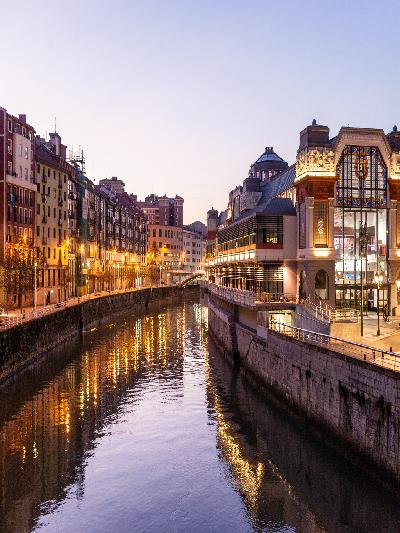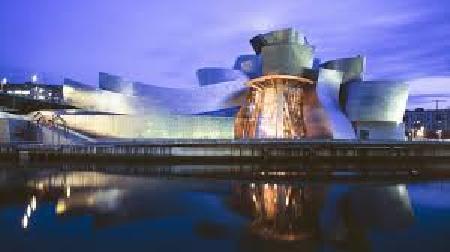 Bilbao is a port city, capital of the province of Bizkaia, in the autonomous community of the Basque Country, northern Spain. Bilbao is located in the central-northern part of Spain, some 16 kilometers south of the Bay of Biscay, where social economic development is located, where the Bilbao estuary is formed. Its main urban nucleus is surrounded by two small mountain ranges with an average elevation of 400 meters.
Bilbao is a port city, capital of the province of Bizkaia, in the autonomous community of the Basque Country, northern Spain. Bilbao is located in the central-northern part of Spain, some 16 kilometers south of the Bay of Biscay, where social economic development is located, where the Bilbao estuary is formed. Its main urban nucleus is surrounded by two small mountain ranges with an average elevation of 400 meters.
It is the largest municipality in the Autonomous Community of the Basque Country and the tenth largest in Spain, with a population of 353,187 inhabitants in 2010. The Bilbao metropolitan area has approximately 1 million inhabitants, making it one of the areas most populated metropolitan areas in northern Spain; With a population of 875,552 inhabitants, becoming the region of Greater Bilbao, it is the fifth largest urban area in Spain. Bilbao is also the main urban area in what is defined as the Great Basque Region.
Weather:
Located on the banks of the Nervión, Bilbao is the largest city in the Basque Country of Spain. Softer and rainier than most other parts of Spain (temperatures here rarely drop below freezing in winter nor rise above 35C even in midsummer.
Sunny days in the city are often strange even for locals, so tourists should stock up on umbrellas and long-sleeved clothing. Otherwise, the long walks through the streets of Bilbao will end the first day with a heavy rain.
History:
The city owes its foundation to Don Diego López de Haro, who in mid-June 1300 promised to turn the fishing village into a commercial settlement. Bilbao did not participate in the Spanish internal battles, but suffered the wars with France. During civil strife, the city was under siege, but it gave the enemy a decent response, forcing it to retreat. The Second Carlist War temporarily deprived the locals of the support of the sea, but this time the enemy was defeated, leaving their positions after many days of fighting. All subsequent attempts by the Carlists to capture Bilbao ended in failure.
The city's entrenched position as a flourishing point for commerce led the British to think about building a port, but the outbreak of the Carlist Wars uprising in 1874 prevented these plans from materializing. Beginning in the 1870s, Bilbao experienced rapid industrialization based on the export of iron ore and the development of the steel and shipbuilding industries. The growth of the industry attracted workers from other parts of Spain, and its presence soon provoked a reaction in the form of Basque nationalism. After the fall of Franco's Spain and the establishment of a constitutional monarchy, in a process known in Spain as the transition, Bilbao was able to hold democratic elections again. This time the Basque nationalists rose to power. Tourism and services have grown in importance since the decline of the steel and shipbuilding industries in the 1960s and 1970s. With the approval of the Statute of Autonomy of the Basque Country in 1979, Vitoria-Gasteiz was chosen as the seat of government and, therefore, as the de facto capital of the Basque Autonomous Community, although Bilbao was bigger and more economically powerful. In the 1980s, various factors such as terrorism, the demand for labor, and the arrival of cheap labor from abroad led to a devastating industrial crisis. The opening in 1997 of the Guggenheim Museum Bilbao, designed by the American architect Frank Gehry in curved shapes and coated with titanium, attracted a large number of tourists. Also in the 1990s, the city's redevelopment projects included a metro system, the improvement of the airport and the port, the construction of a conference center and a concert hall (1999; headquarters of the Bilbao Symphony Orchestra) , the cleaning of the estuary and a development on the coast near the Guggenheim that replaced the old shipyards with a cultural and business center. At the beginning of the 21st century, income from tourism had alleviated the effects of the decline in heavy industry, and the Bilbao metropolitan area, which contained almost half of the total population of the autonomous community, continued to expand.
What to see:
Although Spain is mainly known for other tourist centers, Bilbao also has a lot to offer. Throughout the city you can find museums, churches, palaces and parks that are scattered throughout the city, attracting tourists from all over the world.
Guggenheim museum:

The Guggenheim Museum - Bilbao's main attraction - contains a unique collection of 20th century art. Here you can find works with the best trends such as surrealism, abstractionism, cubism with works by Picasso and Salvador Dalí. In addition to other works such as Andy Warhol, Richard Serra and, of course, dozens of young and talented artists and sculptors whose creations amaze the imagination. And the home of all this art-absence is a masterpiece of the deconstructivism of the famous architect Frank Owen Gehry: a building covered with titanium plates in a complex shape, reminiscent of a spaceship or an alien flower.
Old Town:
You always have to start knowing a city where the first chapters of its history were written. Bilbao was born in the Old Town, 700 years later, but the cobbled streets still retain their medieval charm. A long time ago, wealthy citizens lived on the right bank of the Nervión River, making the entire neighborhood a solid attraction: pompous mansions, palaces, churches, and monuments that criss-cross each other, surprising the variety of styles and ingenuity of the architects. The Teatro Arriaga, the Palacio Juan, the churches of San Antonio and San Juan, the Mercado de la Ribera and other spectacular buildings are especially notable in the 7 streets interwoven in the form of a spider web. The shady Jardines del Arenal, numerous shops and restaurants await visitors who wish to take a break after walking.
Take a boat trip on the Bilbao estuary:
One of the best ways to explore the city of Bilbao is by boat, along the Ría del Nervión or Bilbao, since many of the main attractions are along its banks. Take a walk with Bilboats to see places like the Guggenheim Museum, the Ribera Market, the historic Hotel Arenal Bilbao and the Town Hall.
Bilbao Cathedral:
The Cathedral of Santiago de Bilbao is located in the center of the Casco Antiguo neighborhood and is one of the most recognized places in the city. Dedicated to the Apostle Santiago, it was built during the 15th century and is Gothic in style. The cathedral also has two porticos, one Renaissance and one neoclassical.
Basque Museum:
The Basque Museum is a museum dedicated to the history and culture of the Basque people.
Cafes and restaurants Bilbao:
Bilbao is the best place to get to know Basque cuisine, with French and Spanish reminiscences, but with many characteristics. Basques have a passion for fish and seafood, meat is preferred for beef (most often in the form of grilled steaks) and chicken, but pork is rarely eaten. Greens and spices are not abused, trying to maximize the natural flavor of the products and paying special attention to their freshness.
Security:
The Basque Country is one of the safest areas in Europe. Bilbao is usually a completely safe city, including for tourists, but it is always advisable to take precautions to avoid any mishap.
